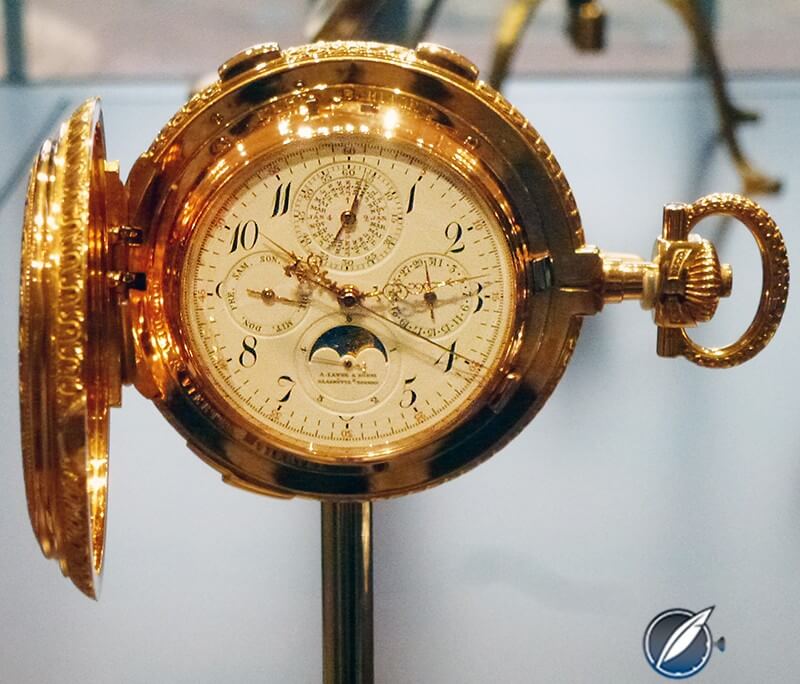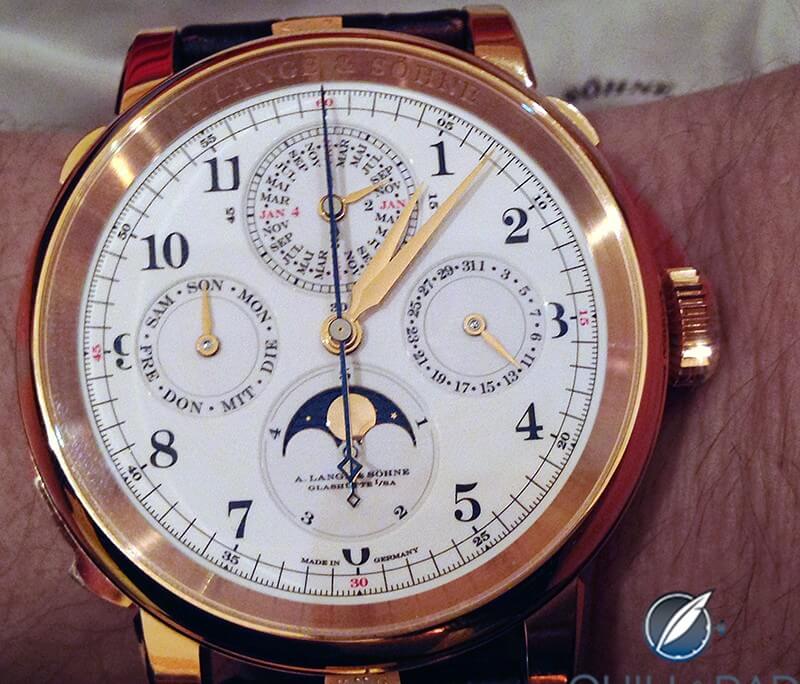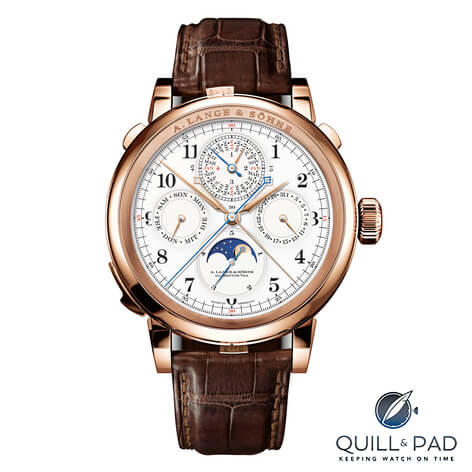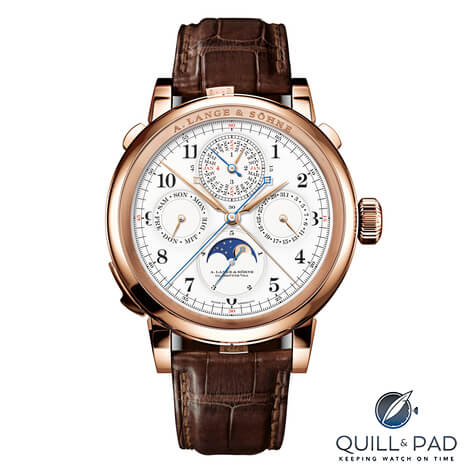Traditionally, the right to be called a grand complication is reserved for timepieces containing at least three of horology’s most difficult complications: a chronograph or split-seconds chronograph; an astronomical complication such as a perpetual calendar; and a striking complication, e.g repeater or sonnerie. Naturally, these rules are unwritten and therefore subject to interpretation. It almost goes without saying that very few brands can make or have made a true grand complication.
A. Lange & Söhne’s Grand Complication fulfils these traditional criteria and more: containing seven complications, it is the most complex wristwatch ever created by the traditional German manufacture, and quite likely is the most complex wristwatch ever made by anyone in Germany. Its functions include grand sonnerie, petite sonnerie, minute repeater, perpetual calendar, and monopusher split-seconds chronograph (thus fulfilling all three of the criteria) in addition to foudroyante seconds (“flying” or “jumping” seconds) and a moon phase display. One watchmaker will work on a single timepiece for an entire year, assembling, adapting and regulating all of the Caliber L.1902’s 876 components. In case you were not aware, A. Lange & Söhne uniquely assembles each movement twice: the first time to ensure everything works as planned, the second with final finishing.
 The Grand Complication was inspired by the Reference 42500 pocket watch, which arrived in A. Lange & Söhne’s workshops unexpectedly in 2001. Its appearance confirmed the continued existence of the most significant timepiece ever to leave Lange’s original, pre-war workshops when it was sold to a Viennese gentleman in 1902. “This watch,” explained Jan Sliva, head of restoration, “unites a host of fascinating complications. It incorporates a chiming mechanism with a grand strike and a small strike, a minute repeater, a split-seconds chronograph with a minute counter and flying seconds (foudroyante), as well as a perpetual calendar with a moon-phase display.”
The Grand Complication was inspired by the Reference 42500 pocket watch, which arrived in A. Lange & Söhne’s workshops unexpectedly in 2001. Its appearance confirmed the continued existence of the most significant timepiece ever to leave Lange’s original, pre-war workshops when it was sold to a Viennese gentleman in 1902. “This watch,” explained Jan Sliva, head of restoration, “unites a host of fascinating complications. It incorporates a chiming mechanism with a grand strike and a small strike, a minute repeater, a split-seconds chronograph with a minute counter and flying seconds (foudroyante), as well as a perpetual calendar with a moon-phase display.”
Sliva and his colleagues restored this historic treasure, documenting its functions, interactions, and individual components as they went along. Its extensive restoration took eight years, the result of which was publicly displayed for the first time at SIHH 2010.
Connoisseurs of A. Lange & Söhne have been very patient in waiting for a real repeating movement – the Zeitwerk was a teasing precursor, only striking the hour – and what they ended up getting in 2013 was not only the desired repeating movement, but more than they could ever have dreamed possible. The handmade gongs of the Grand Complication were fashioned according to elements found in Reference 42500.
The incredibly clear and sonorous chimes of the grand and petite sonnerie and the minute repeater, powered by one of a total of three mainsprings wound by the crown (winding in a clockwise direction tensions the mainsprings for the movement and the chronograph; winding in the opposite direction tensions the chiming mechanism’s mainspring), is a point of pride for Anthonie de Haas, head of product development at A. Lange & Söhne. The jovial Dutchman’s specialty at his previous job as a prototypist at Audemars Piguet Renaud et Papi was minute repeaters. He has spent hours over the years explaining to me that the balance between the forces and the gongs are what make a great repeater. “And most repeaters are much too fast,” he told me just a month ago in Dresden as we explored the completed Grand Complication together. Proving his point, the chiming of the Grand Complication seemed to me languid, relaxed and simply majestic.
You can hear the sound for yourself in the video above.
Aside from the minute repeater, the Grand Complication is also equipped with a grand sonnerie and a petite sonnerie, which the wearer has the option of selecting. The chosen mode is represented by the “K” and a “G” shown on the slide at the bottom of the case between the lower lugs (K for “klein” and G for “groß”; “small” and “large” in German). The watch also offers the possibility of a silent mode, which is located on the opposite side of the case between the upper lugs. The “S” represents strike (“Schlagen”) and “R” means silence (“Ruhe”).
So with the host of talented technicians at A. Lange & Söhne, including de Haas and two watchmakers he said now completely master the art of the repeater, why did the company make its loyal collectors wait so long for such a timepiece? The answer is actually quite simple: de Haas is a perfectionist. Listen to the video to judge for yourself; we think you’ll agree this is one of the most superb chimes a timepiece has ever produced despite the case crafted in gold, which generally dampens sound. Proving, of course, that patience is a virtue, which de Haas already knows.
 The Grand Complication includes a monopusher split-seconds chronograph, making it the ninth chronograph system developed by A. Lange & Söhne in the last 20 years; this one contains two column wheels overseeing the action. The gold hand of the chronograph is controlled by the pusher at 1:30, while the rattrapante’s blued-steel hand is controlled by the pusher at 10:30.
The Grand Complication includes a monopusher split-seconds chronograph, making it the ninth chronograph system developed by A. Lange & Söhne in the last 20 years; this one contains two column wheels overseeing the action. The gold hand of the chronograph is controlled by the pusher at 1:30, while the rattrapante’s blued-steel hand is controlled by the pusher at 10:30.
This German brand is not one to take shortcuts, and thus the system devised for the foudroyante seconds – which is an unusual inclusion in a grand complication – displayed by a little blued-steel hand sharing a subdial with the moon phase at 6 o’clock is also worth taking a closer look at. In fact, A. Lange & Söhne’s engineers had to create an extra wheel train to include this function. De Haas, who said he finds this to be a very underappreciated indication, also explained that the long road to perfecting it included experimentation with diamond coating on the star wheel to protect it from the undue stress created by the lightning-quick indication, which divides the chronograph-timed second into visible fifths, thereby emulating the balance’s frequency of 2.5 Hz (18,000 vph). In the end, de Haas and his team didn’t use that solution, opting instead to solve the friction problem with recalculated geometry. “All the components in our grand complication are made using traditional materials,” he confirmed.
 Remember what I said about the absence of shortcuts before? Another example of this is the lever escapement used in manually wound Caliber L1902: it is not the ubiquitous Swiss lever escapement, but rather a variation on the theme with slightly recalculated geometry known as the Glashütte lever escapement. Its lever and escape wheel are unusually crafted in 18-karat gold, and it is paired with a balance spring that has been crafted in-house at A. Lange & Söhne.
Remember what I said about the absence of shortcuts before? Another example of this is the lever escapement used in manually wound Caliber L1902: it is not the ubiquitous Swiss lever escapement, but rather a variation on the theme with slightly recalculated geometry known as the Glashütte lever escapement. Its lever and escape wheel are unusually crafted in 18-karat gold, and it is paired with a balance spring that has been crafted in-house at A. Lange & Söhne.
The beautiful “face” of the Grand Complication comprises an enamel dial made of no less than five parts comprising the main dial and four subdials. Only one dial in twenty survives the enamel process, making the survivors as rare and costly as they are beautiful. The moon phase at 6 o’clock boasts Lange’s high-standard accuracy of 122 years, and the solid gold moon floating within a dark-blue enameled sky is a miniature work of art in itself.. Thanks to a few new hires in 2013, this moon is now painted by an in-house enameller. All in all, despite the extremely high number of displays, the balanced nature of this dial is commendable – though, truly, we have come to expect nothing less of A. Lange & Söhne.
Limited to only six pieces retailing for € 1.92 million apiece, each one was spoken for before the first one was ever completed, demonstrating the loyalty of A. Lange & Söhne’s collectors as well as the quality that we have come to love and expect from this most traditional of Saxon brands.
Quick Facts
Case: 50 mm x 20.3 mm, rose gold
Movement: manually wound Caliber L1902
Functions: hours and minutes; chiming mechanism with minute repeater, grande et petite sonnerie; monopusher split-seconds chronograph with foudroyante seconds; lever for selecting grand or small strike; lever for silence or strike; perpetual calendar with moon phase
Trackbacks & Pingbacks
-
[…] grand complications: 1. A Lange & Sohne Grand Complication (see A. Lange & Söhne Grand Complication’s Secret Ingredients) 2. Jaeger-LeCoultre Reverso Grande Complication à […]
-
[…] manufactured the most complicated wristwatch to come from Glashütte: the Grand Complication. See A. Lange & Söhne Grand Complication’s Secret Ingredients (Live Images + Pricing) for complete information on this […]
-
[…] can see a sister timepiece to this one in a story I wrote for Quill & Pad right at the beginning of January as one of my first posts, a most impressive grand complication […]
-
[…] a stellar moment for the rare grand complication, as the SIHH quickly demonstrated. Not only did A. Lange & Söhne present its oeuvre, but to celebrate the twentieth anniversary of the sporty, contemporary Royal Oak […]
Leave a Reply
Want to join the discussion?Feel free to contribute!


I have been reading out many of your articles and i must say nice stuff. I will surely bookmark your website.
Thank you for your support.
Yes, and further more if you would like update alerts from this site at that time you have to subscribe for it Quill & Pad | A. Lange & Söhne Grand Complication’s Secret Ingredients (Live Images Pricing) , it will be a better for you Jackson. Have a fine day!
Umm, I could use a cliffs notes version of the post? lol